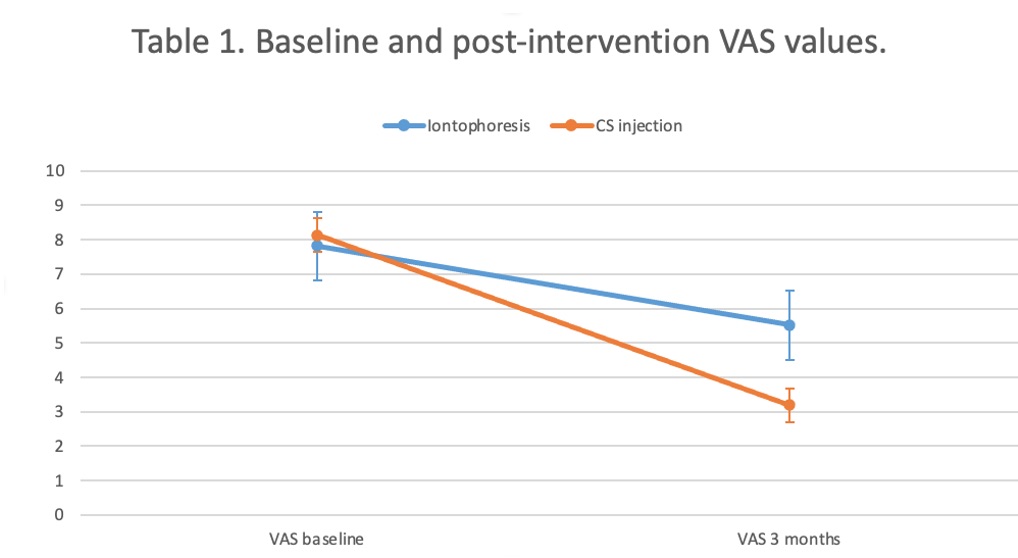Session Information
Session Type: Poster Session B
Session Time: 10:30AM-12:30PM
Background/Purpose: Trapeziometacarpal osteoarthritis is a common degenerative disease that causes pain and thumb dysfunction. It affects 16-25% of the population, mainly middle-aged women. Treatment modalities consist of non-pharmacological (resting, immobilization with splints etc) and pharmacological measures (analgesics, topical or oral non-steroidal anti-inflammatory drugs (NSAIDs), corticosteroid (CS), hyaluronic acid, platelet-rich plasma or autologous fat injections as well as surgery. The objective was our study was to compare efficacy and safety of ultrasound-guided intra-articular corticosteroid injection versus iontophoresis in patients with rhizarthrosis.
Methods: A prospective comparative two-arm study was carried out in patients with symptomatic rhizarthrosis, treated inrheumatology departments of two hospitals. Baseline evaluation was performed, followed by application of iontophoresis or ultrasound-guided intra-articular injection of triamcinolone acetonide, according to the physician’s criteria and patient´s preferences. Demographic and clinical characteristics of the patients were collected, as well as the values of pain VAS, both at baseline and after 3-month. Mann-Whitney U test was used to analyze the difference in distribution by sex, age and duration of the disease between the two groups, as well as to compare the difference in the efficacy of both treatments.
Results: The study included 56 patients, 27 patients in the iontophoresis group and 29 in the CS injection group. Forty-seven (83.9%) were women, and the mean age was 64 years (46-85), with a median duration of the disease of 3 years. In 2 patients (3.57%) no intervention was performed due to spontaneous improvement of pain. A rest splint was recommended in both groups. The two groups (iontophoresis and corticosteroid injection) were comparable in age (p=0.718), disease duration (p=0.548) and baseline VAS (p=0.205), but not in sex (p=0.015) due to 3,7% vs 24% men in iontophoresis and CS injection group respectively. The results of the application of iontophoresis and ultrasound-guided infiltration of triamcinolone acetonide are shown in Table 1. Ultrasound-guided intra-articular corticosteroid injection showed to be significantly more effective than iontophoresis (p=0.003). Both procedures were safe and no adverse events were reported.
Conclusion: Ultrasound-guided intraarticular corticosteroid injection is useful in patients with symptomatic rhizarthrosis and showed to be more effective than iontophoresis in our setting. Studies with a larger number of patients are necessary to confirm these results.
To cite this abstract in AMA style:
Rusinovich O, Liso Andrino A, Sanchez M, Navarro Alonso P, Cantalejo Moreira M, DIAZ OCA A, Navarro Palomo P, Machattou M, Alonso de Francisco M, Navarro Joven C, Martinez Rodado A, Ramos Ortiz de Zarate l, Godoy Tundidor h, Barbadillo Mateos M, Garcia-Magallon B, Campos J, Fernández Castro M, SANZ SANZ J, Andreu J. Ultrasound-Guided Corticosteroid Injection versus Iontophoresis in Rhizarthrosis: A Prospective Comparative Multicentric Study [abstract]. Arthritis Rheumatol. 2024; 76 (suppl 9). https://acrabstracts.org/abstract/ultrasound-guided-corticosteroid-injection-versus-iontophoresis-in-rhizarthrosis-a-prospective-comparative-multicentric-study/. Accessed .« Back to ACR Convergence 2024
ACR Meeting Abstracts - https://acrabstracts.org/abstract/ultrasound-guided-corticosteroid-injection-versus-iontophoresis-in-rhizarthrosis-a-prospective-comparative-multicentric-study/

